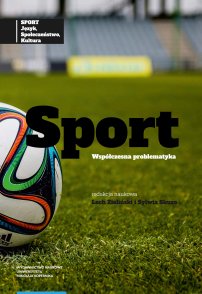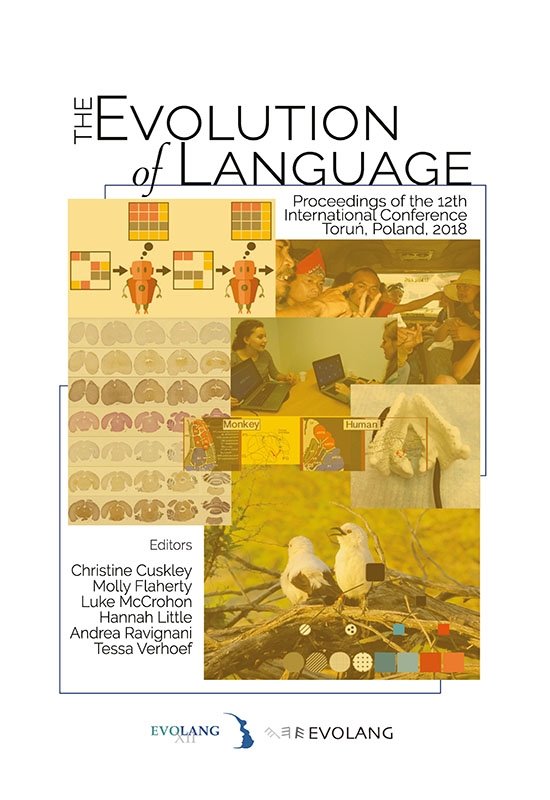The Evolution of Language. Proceedings of the 12th International Conference on the Evolution of Language (Evolang12)
Evolang XII - podniesienie rangi naukowej oraz promocja kongresu Evolang XII - zadanie finansowane w ramach umowy 773/P-DUN/2018 ze środków Ministra Nauki i Szkolnictwa Wyższego przeznaczonych na działalność upowszechniającą naukę

Evolang XII - the publication of the proceedings has been funded by the Polish Ministry of Science and Higher Education as part of the 773/P-DUN/2018 agreement

Preface / v
Plenary Talks / 1
Iconicity in sign language / 2
Karen Emmorey
Children are both more conservative and more likely to generalize than adults for the same reason / 3
Adele Goldberg
Music before language: Observations from a hunter-gatherers point of view / 4
Jerome Lewis
Human and pre-human culture and the evolution of language / 5
Andrew Whiten
Refereed Contributions / 7
Speech acts addressed at Hadza infants in Tanzania / 8
Monika Abels, Paul Vogt
Towards a domain-relevant approach to the evolution of language and music / 12
Rie Asano
Linguistic and non-linguistic correlates in the evolution of phonotactic diversity / 15
Andreas Baumann, Theresa Matzinger, Nikolaus Ritt
Linguistic stability increases with population size, but only in stable learning environments / 19
Andreas Baumann
Can Languages without writing systems provide new insights in language evolution? / 31
Christina Behme
Language family trees reect geography and demography beyond neutral drift / 38
Christian Bentz, Dan Dediu, Annemarie Verkerk, Gerhard Jager
Do non-native speakers create a pressure towards simplification? Corpus evidence / 41
Aleksandrs Berdicevskis
A critical period for the evolution of language-readiness: Clarifying the Globularization hypothesis / 44
Cedric Boeckx
Modelling the Effect of Iconicity on Iterated (Cross-Situational) Learning / 47
Bart de Boer
Gestures reected - Tracing gestural development from a child's EEG signal / 50
Monika Boruta, Joanna Dreszer, Natalia Pawlaczyk, Magdalena Kmiecik, Monika Grzybowska, Agnieszka Ignaczewska, Włodzisław Duch
Trends in evolution of signals' interpretation as precursors of the origin of human language / 53
Svetlana Burlak
Interactive sequences modulate the selection of expressive forms in cross-signing / 67
Kang-Suk Byun, Sean Roberts, Connie de Vos, Ulrike Zeshan, Stephen C. Levinson
Conceptual structure is shaped by competing pressures for simplicity and informativeness / 70
Jon W. Carr, Kenny Smith, Jennifer Culbertson, Simon Kirby
Iconicity and convention in the manual modality: Pantomime in language origins /73
Erica Cartmill
Beat perception in a non-vocal learner: Rats can identify isochronous beats / 76
Alexandre Celma-Miralles, Juan M Toro
How domain-specific is merge? / 80
Dan Cook, Mauricio Martins
Statistical learning and language (in spite of arbitrariness) / 83
Davide Crepaldi, Simona Amenta, Marco Marelli
Alien symbols for alien language: Iterated learning in a unique, novel signal space / 86
Christine Cuskley
Cultural transmission of melodic and rhythmic universals: 4 experiments and a model / 89
Tania Delgado, Andrea Ravignani, Tessa Verhoef, Bill Thompson, Thomas Grossi, Simon Kirby
Phylogeny in phonology: Tai sound systems encode their evolutionary history / 92
Rikker Dockum
Metaphorical Extension and the Evolution of Con_gurationality / 95
T. Mark Ellison, Uta Reinohl
From Cognition to Language Change: Close Simulation of a PNG Village / 98
T. Mark Ellison, Eri Kashima
Meaning-refining acoustic variation within the internal structure of pied babbler recruitment cries / 101
Sabrina Engesser, Amanda Ridley, Marta Manser, Simon Townsend
Structural cues for symmetry, asymmetry and non-symmetry in central Taurus sign language / 104
Rabia Ergin, Ann Senghas, Ray Jackendo, Lila Gleitman
Dual-Processing and the Representational Hypothesis: Accounting for the emergence of language / 107
Andrew Feeney
Semantic conditioning in interaction and transmission / 111
Olga Feher, Elizabeth Wonnacott, Hanna Jarvinen, Kenny Smith
The coevolution of data and hypotheses in bayesian cultural evolution / 114
Vanessa Ferdinand
The evolution of optimized language in the light of standard information theory / 122
Ramon Ferrer-I-Cancho, Chris Bentz
Do we see word order patterns from silent gesture studies in a new natural language? 125
Molly Flaherty, Marieke Schouwstra, Susan Goldin-Meadow
A rational model of linguistic accommodation and its potential role in language simplification / 128
Stella Frank, Kenny Smith
Non-communicative functions can be equally important for studies of language evolution / 131
Koji Fujita
Primate songs and their relevance in the study of language evolution / 134
Marco Gamba, Valeria Torti, Daria Valente, Chiara de Gregorio, Olivier Friard, Cristina Giacoma
How the evolution of teaching may help understanding the evolution of language / 137
Peter Gardenfors
Pattern similarity in biological, linguistic, and sociocultural evolution / 139
Nathalie Gontier
Human and porcine vocalizations after creation of a human larynx / 150
Kari Green, Robert Morrison, Glenn Green
Natural selection in the modern english lexicon / 153
Jack Grieve
Learning to communicate about conceptual hierarchies / 158
Robert Hawkins, Kenny Smith, Michael Franke, Noah Goodman
Linguistic laws in chimpanzee gestural communication / 161
Raphaela Heesen, Catherine Hobaiter, Ramon Ferrer-I-Cancho, Stuart Semple
Communication of cognition? A minimal computational model of evolutionary interactions between individual and social learning / 165
Masahiko Higashi, Reiji Suzuki, Takaya Arita
When is a code not a code? / 168
Elizabeth Irvine
Agent model reveals the influence of vocal tract anatomy on speech during ontogeny and glossogeny / 171
Rick Janssen, Dan Dediu, Scott Moisik
Triangulating sound symbolism where to find it and how to create it / 175
Niklas Johansson
Clues to language evolution from a massive dataset with typology, phonology, and vocabulary from many languages / 178
Sverker Johansson
Environmental constraints in the evolution of scalar concepts: Road to most / 181
Dariusz Kalociński
Identifying linguistic selection and innovation while controlling for cultural drift / 189
Andres Karjus, Richard A. Blythe, Simon Kirby, Kenny Smith
Temporal adjustment of short calls during vocal exchange in Japanese macaques / 193
Noriko Katsu, Kazunori Yamada, Masayuki Nakamichi, Kazuo Okanoya
Learning implicational models of universal grammar parameters / 196
Dimitar Kazakov, Guido Cordoni, Andrea Ceolin, Monica Irimia, Shin-Sook Kim, Dimitris Michelioudakis, Nina Radkevich, Cristina Guardiano, Giuseppe Longobardi
The role of teaching in iterated language transmission / 206
Vera Kempe, Kamil Cichon, Monica Tamariz, Nicolas Gauvrit
Incremental word processing helps shape the lexicon / 209
Adam King, Andrew Wedel
The origins of word order universals: Evidence from corpus statistics and silent gesture / 212
Simon Kirby, Jennifer Culbertson, Marieke Schouwstra
Constituent Order in Improvised Gesture Reflects Speaker Perspective / 215
Fiona Kirton, Marieke Schouwstra, Jennifer Culbertson, Kenny Smith, Simon Kirby
Pressure for trust-based efficiency shaped the evolution of language / 218
Chris Knight
Do children use „fine” ostensive communication? / 230
Harumi Kobayashi, Tetsuya Yasuda
Recontextualization: The Dynamics of Language Behavior and Change / 232
Anneliese Kuhle, Ferdinand von Mengden
Mammalian models for the study of vocal learning: A new paradigm in bats / 235
Ella Lattenkamp, Sonja Vernes, Lutz Wiegrebe
Sequencing bat genomes to shed light on language evolution / 238
Ksenia Lavrichenko, Sonja Vernes
The Method of Validation by Zenith / 241
David Leavens
What 50 Million Drawings Can Tell Us About Shared Meaning / 243
Molly Lewis, Gary Lupyan
What do iconicity judgements really mean? / 246
Hannah Little, Justin Sulik
Physical features of social networks and language typology / 249
Matthew Lou-Magnuson, Luca Onnis
Core Knowledge or language-augmented cognition? The case of geometric reasoning / 252
Gary Lupyan, Ashley Wendorf, Luis Miguel Berscia, Jing Paul
Gesture, sign and beyond. Negation across three generations of signers / 255
Hannah Lutzenberger
Symbol and its evolution / 258
Erkki Luuk
Greeting and meeting: Vocal interactions and use of signature whistles in bottlenose dolphins during an introduction / 270
Heidi Lyn, Megan Broadway
What can sound symbolism tell us about the evolution of language? A comparative study in humans and great apes / 278
Konstantina Margiotoudi, Manuel Bohn, Matthias Allritz, Friedemann Pulvermuller
The cultural evolution of communicative conventions: Interactions between population connectivity dynamics and cognitive biases / 281
Jose Segovia Martin, Monica Tamariz
Sound Production Learning and the Contiguum Hypothesis / 284
Pedro Tiago Martins, Cedric Boeckx
The human Arcuate Fasciculus provides specific advantages to process complex sequential stimuli, not hierarchies in general / 287
Mauricio Martins, Arno Villringer
A potential link between infant-directed speech and evolution of vocal communication / 290
Reiko Mazuka, Tadahisa Kondo, Akiko Hayashi
Identifying the Ape Beat in the Wild: Rhythmic Individual Signatures from the Sounds of Manual Fruit Cracking in Fongoli Chimpanzees / 293
Adrien Meguerditchian, Adelyne Vuillemin, Jill D. Pruetz
Topic-openendedness: Why recursion is overrated / 295
Irit Meir
Dynamical preferences and self-actuated language changes / 306
Jerome Michaud
The prevalence of repair in studies of language evolution / 316
Ashley Micklos, Vinicius Macuch Silva, Nicolas Fay
The emergence of adjacency pairs: No evidence is better than negative evidence / 319
Gregory Mills
Differential rates of change in consonant and vowel systems / 322
Steven Moran, Annemarie Verkerk
The cultural evolution of spatial modulations in artificial sign languages / 326
Yasamin Motamedi, Marieke Schouwstra, Kenny Smith, Jennifer Culbertson, Simon Kirby
Evolutionary Stability of Linguistic Politeness and the Politeness Equilibrium Principle / 329
Roland Muhlenbernd, Przemyslaw Zywiczynski, Slawomir Wacewicz
The influence of shared visual context on performance with novel codes in a referential communication game / 332
Thomas Muller, Tiffany Morisseau, James Winters, Olivier Morin
A domesticated code: On the emergence of the oscillatory basis of phrase structure / 335
Elliot Murphy
Semantic bleaching not observed in synchronic test / 339
Dillon Niederhut
Comparative morphology of the laryngeal muscles in hylobatids using a high-resolution MRI / 346
Takeshi Nishimura, Yoshitaka Nomura, Hirohiko Imai, Tetsuya Matsuda
Environmental and social factors motivate the emergence of systematic categories and signs / 349
Jonas Nolle, Marlene Staib, Riccardo Fusaroli, Kristian Tylen
The evolutionary causes of irregularity: Evidence for an irregularization bias in morphological learning / 352
Timothy O’Donnell, Kenny Smith
Evolution of Homophones and Syntactic Categories Noun and Verb / 355
Mieko Ogura, William Wang
Language as a parasite to emotional signals / 364
Kazuo Okanoya
Socio-environmental Constraints in Category Learning / 367
Katarzyna Oktaba, Dariusz Kalocinski
Simplicity biases operate at item and system level. An iterated learning study / 370
Aliki Papa, Miriam Stadje, Simon Kirby, Monica Tamariz
A conceptual escape from the perils of universal grammar / 372
Joel Parthemore
Evolution of phoneme usage driven by phonetic robustness for error minimization / 376
Ines Pena, Marco Archetti
The evolutionary dynamics of language as a function of demography / 379
Dirk Pijpops, Katrien Beuls, Freek Van de Velde
Language evolution and the emergence of constructions in interaction / 382
Michael Pleyer
Pinnipeds have something to say about speech and rhythm / 399
Andrea Ravignani, Maxime Garcia, Stephanie Gross, Koen de Reus, Nienke Hoeksema, Ana Rubio Garcia, Bart de Boer
The role of community size in the emergence of linguistic structure / 402
Limor Raviv, Antje Meyer, Shiri Lev-Ari
Conceptual categories scaffold verbal semantic structure: A cross-cultural study of child homesign / 405
Lilia Rissman, Laura Horton, Susan Goldin-Meadow
Word form shapes are culturally selected for indicating their morphological structure / 408
Andreas Baumann, Christina Promer, Nikolaus Ritt
CHIELD: Causal hypotheses in evolutionary linguistics database / 412
Sean Roberts
Innovation, selection and the emergence of transparent signals in interaction / 419
Sean Roberts, Ashley Micklos, Justin Sulik, Hannah Little
The emergence of focus in an experimental communication game / 422
Gareth Roberts, Jon Stevens
Compressible kinship terminologies are more learnable than less compressible alternatives / 425
Sara Rolando, Simon Kirby, Kenny Smith
Homo imitans is homo loquens. On vocal imitation / 428
Joana Rossello
The effects of gossip on interpersonal trust depend on prosociality of the gossipers / 431
Konrad Rudnicki, Charlotte de Backer, Carolyn Declerck
Distribution-based Prediction of the Degree of Grammaticalization for German Prepositions / 434
Dominik Schlechtweg, Sabine Schulte Im Walde
Cockatiels: A novel animal model for studying the evolution of music and language / 437
Yoshimasa Seki
What Makes a Grammar Diffcult? Experimental Evidence / 439
Arturs Semenuks, Aleksandrs Berdicevskis
Evidence for High Frequency of Linguistic Rara In European Languages / 442
Arturs Semenuks
Different patterns of iconic inuence in the creation vs. transmission of the Nicaraguan sign language lexicon / 445
Ann Senghas, Jennie Pyers, Caroline Zola, Charlotte Quincoses
Abstraction and universals in theorizing about language evolution / 449
Richard Shillcock
Structural alignment in cross-modal priming: Linguistic representation is shared between gesture and speech / 458
Joleana Shurley, Marieke Schouwstra, Martin Pickering
The Informative Value Of Communicator Disagreement in Great Apes For The Study Of The Evolution Of Human Intentional Communication / 461
Christine Sievers, Thibaud Gruber, Klaus Zuberbuhler
`Give it to me'/`Give it to her': The development of a relational term in homesign and English / 464
Catriona Silvey, Susan Goldin-Meadow
Referential gestures are not ubiquitous in wild chimpanzee communities / 467
Katie Slocombe, Nicole Lahiff, Claudia Wilke, Cat Hobaiter
Does learning favour communicative efficiency? / 469
Kenny Smith, Jennifer Culbertson
Understanding vs. Describing Others' Minds: Mental State Language in a Small-Scale Society / 472
Andrew Marcus Smith, Erica Cartmill, H. Clark Barrett
How sociolinguistic theory can inform cultural evolution, and how to test it / 475
Betsy Sneller, Gareth Roberts
"The greatest story ever told": Semiosis emerging from mimesis and/or narrativity / 478
Goran Sonesson
Language complexity as an interaction between social structure, innovation, and simplicity / 489
Matthew Spike
I see what you did there: The role of iconicity in the acquisition of signs / 492
Asha Sato, Michael Ramsammy, Marieke Schouwstra, Simon Kirby
Success in signaling: the effect of feedback to signaler and receiver / 495
Justin Sulik, Gary Lupyan
Modeling creativity and communication / 498
Justin Sulik
Development of vocal temporal parameters in distantly related vocal learners, birds and humans / 501
Miki Takahasi, Kazuo Okanoya, Reiko Mazuka
Do songbirds perceive syllables as isolated tokens? / 504
Mizuhara Tomoko, Kazuo Okanoya
Difference of two recursions, “hierarchical embedding” and “selfreference”: From view of adaptive functions and implementations / 507
Genta Toya, Rie Asano, Takashi Hashimoto
Communicative asymmetry, handedness and language experience / 510
Olga Vasileva
Cognitive biases and cultural evolution in the emergence of space-time mappings in language / 513
Tessa Verhoef, Esther Walker, Tyler Marghetis
Vocal learning in bats: From genes to behaviour / 516
Sonja Vernes, Ella Lattenkamp, Ksenia Lavrichenko, Janine Mengede
Honeybees learn patterns with ashing lights / 519
Elisabetta Versace, Sara Peruo, Bettina Maccagnani, Giorgio Vallortigara
Rapid turn-taking as a constant feature of signed conversations / 522
Connie de Vos
Phonological grammars evolve to preserve information at word beginnings / 525
Andy Wedel, Adam Ussishkin, Adam King, Jaycie Martin, Jonathon Geary
From context to code: Shared information constrains the evolution of optimal codes / 528
James Winters, Olivier Morin
A model of cultural co-evolution of language and perspectivetaking / 531
Marieke Woensdregt, Kenny Smith, Chris Cummins, Simon Kirby
Infants' sensitivity to emotional animal vocalization and the evolution of vocal communication / 534
Naoto Yamane, Mihoko Hasegawa, Ai Kanato, Naoko Kijima, Kazuo Okanoya, Reiko Mazuka
The English dative alternation as an adaptation to changes in the constructional network / 537
Eva Zehentner
Using language to discover categories: More nameable features improve category learning / 539
Martin Zettersten, Gary Lupyan
Pantolang: A synthetic cognitive-semiotic approach to language origins / 548
Jordan Zlatev, Simon Devylder, Slawomir Wacewicz, Przemyslaw Zywiczynski, Francesco Ferretti, Ines Adornetti, Alessandra Chiera
Vocal accommodation in common marmosets: Does similarity buffer tension during pair bond development? /551
Yvonne Zurcher, Erik P. Willems, Judith M. Burkart
Author Index / 555
Christine Cuskley
Hannah Little
Andrea Ravignani
Molly Flaherty
Luke McCrohon
Tessa Verhoef
Inne z tej kategorii

Do szarży marsz, marsz... Studia z dziejów kawalerii, t. 10
Aleksander Smoliński
Sport: język, społeczeństwo, kultura. Tom II. Sport współczesna problematyka

Za kulisami. Toruńskie spotkania wokół dramatu. Edycja trzecia







